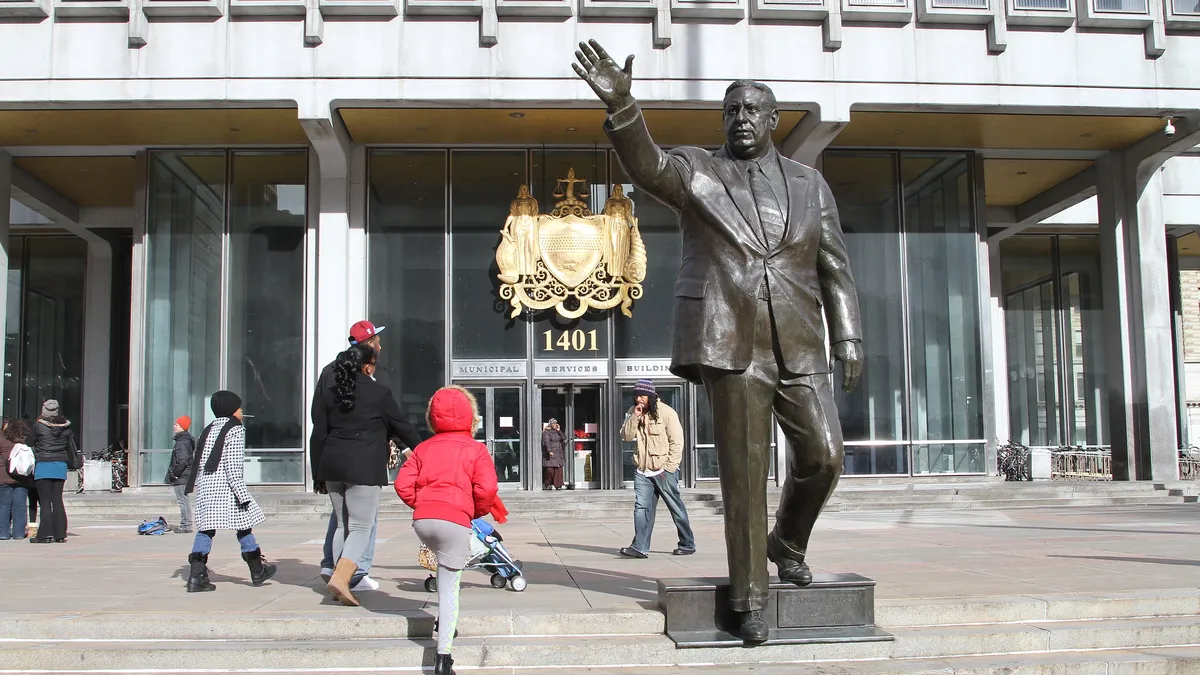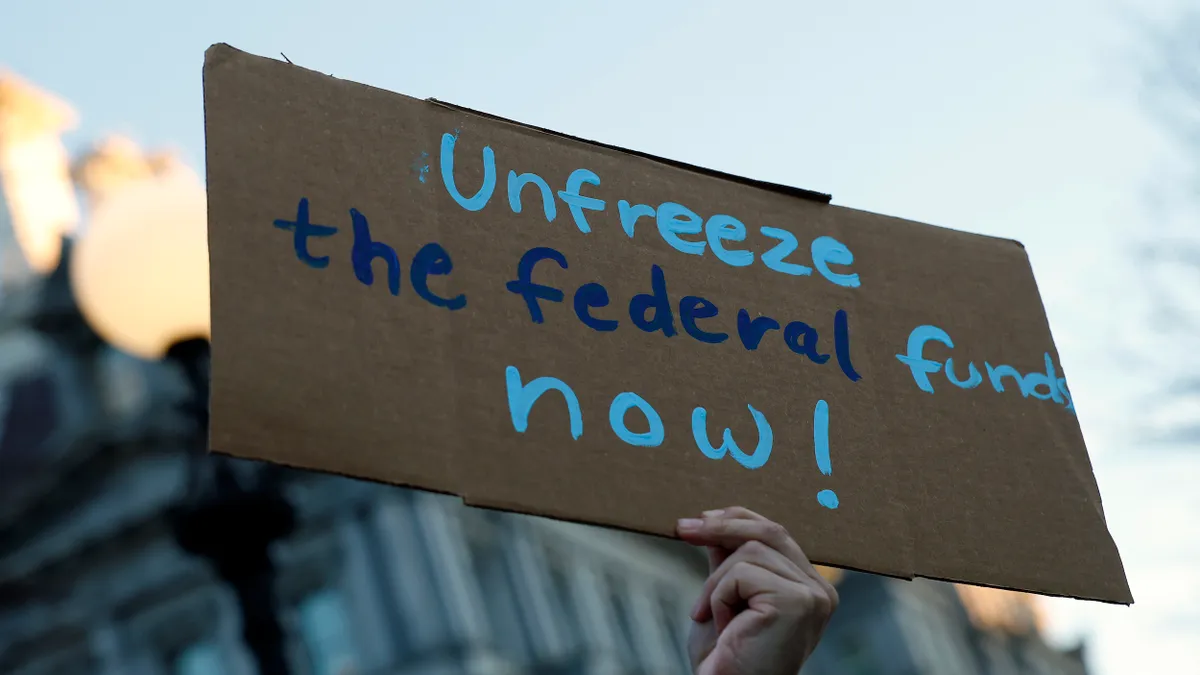In the initial days of nationwide protests against systemic racism started in response to the police killing of George Floyd, marchers in Philadelphia were met with a line of officers at the city's Municipal Services Building, guarding a statue of 1970s mayor and police commissioner Frank Rizzo — a politician who often encouraged Philadelphians to "vote white."
Within days of the demonstrations, Mayor Jim Kenney ordered the statue's removal, calling it a "deplorable monument to racism, bigotry and police brutality."
The statue represented bigotry, hatred, and oppression for too many people, for too long. It is finally gone. pic.twitter.com/30f2Skpqog
— Jim Kenney (@PhillyMayor) June 3, 2020
The removal of Rizzo's statue falls in line with nationwide momentum to bring down controversial city monuments. Some — including Confederate statues in Richmond, VA and a Christopher Columbus statue in Minneapolis — have been toppled over by protesters, while other monuments are under review as cities wrestle with how to bring them down, where to take them and how to fill their vacancies. The process is often difficult, fraught with rules surrounding preservation and safe transport, along with strong public sentiment on the issue.
Tapping into past approaches
The Charleston, SC church shooting in 2015 sparked the initial wave of U.S. cities looking to remove Confederate monuments in public locations. These steps were accelerated following the 2017 Unite the Right rally, during which hundreds of white supremacists marched in Charlottesville, VA to protest the removal of a Confederate statue.
Many cities stood firm on their decisions to take down these historical markers despite the violence and hatred associated with the Charlottesville rally.
For the City of Gainesville, FL, the 2017 removal of the "Old Joe" Confederate monument, located at Alachua County's administration building, was a two-year process. "We went through multiple rounds of public hearings followed by a careful process of determining where to take it," Mark Sexton, communications and legislative affairs director for Alachua County, told Smart Cities Dive.
Finding a taker for the statue proved challenging, and involved a variety of alternatives, including a museum, veteran’s park and cemetery. Ultimately, the local chapter of the United Daughters of Confederacy took possession of the monument.
"They hired a monument company to remove it ... and they took it to a cemetery in an unincorporated part of town," Sexton said. Like many municipalities, Gainesville removed the statue without an announcement and with no fanfare in an effort to ensure the removal wouldn’t draw crowds.
In Annapolis, MD, the process of removing the 19th century bronze statue of Roger Taney, author of the Dred Scott decision, was fairly straightforward as it was part of the state’s art collection. Until 2017, the statue stood at the entrance of the Maryland State House.
"There was no question of melting it down or tossing it into a parking lot," Elaine Rice Bachmann, deputy state archivist, told Smart Cities Dive.
The state brought in two cranes to move the heavy statue and immediately covered the base upon which it stood. The state made no announcement about the statue’s removal and rapidly mobilized after shutting down traffic in the circle surrounding the state house.
"We had a real fear of being a target of protest so we wanted to move quickly and quietly," said Rice Bachmann.
There are no plans to mark the spot where the Taney statue stood. “We take the stance that we restored the state house to its original façade,” said Rice Bachmann. "Right now the statue is under curatorial storage, where it will remain until we can put together an interpretive display for it."
The decision to remove Ellicott City, MD's Confederate monument to local soldiers also came in 2017 following the Charlottesville protests. The process required a five-day public notice following a county council vote on the matter.
#BREAKING Howard County Executive Allan Kittleman reporting the confederate memorial has now been removed from the courthouse. https://t.co/pfhHfQY2QP
— Megan Gilliland (@MeganReports) August 22, 2017
"Before we could determine where to take the monument, we had to go through a historic review process," Howard County Executive Calvin Ball, who was a council member at the time, told Smart Cities Dive. "We had it moved to the local historical society as part of a Civil War exhibit."
Not having the expertise to move the monument, the county hired a local cemetery monument company, which removed it from the courthouse grounds in pre-dawn hours. Ball said there are no plans to denote where the monument originally stood.
Tough decisions ahead
While at least 44 Confederate monuments have been uprooted since the Charlottesville protests, more than 700 remain in the U.S., according to Al Jazeera. Last week, Reps. Barbara Lee, D-CA, and Bennie Thompson, D-MS — senior members of the Congressional Black Caucus — introduced legislation that would remove 11 Confederate statues from the Capitol’s National Statuary Hall Collection, a move that immediately followed House Speaker Nancy Pelosi's call for their removal.
In the meantime, some cities are following in Philadelphia's footsteps by making the call for themselves. Fredericksburg, VA last week removed a 176-year-old slave auction block from a prominent street corner, a monument that was the subject of years-long debates.
In determining how to handle the block's removal and relocation, the city council consulted with the International Coalition of Sites of Conscience (ICSC), an organization dedicated to reconciliation in communities divided over issues of race.
"We considered several options on where the block would end up," said Sonia Cantu, Fredericksburg’s public information officer. "We don’t put things on private property. Ultimately we decided to loan it to the Fredericksburg Area Museum for 20 years."
For the physical removal of the 800-pound block, made of fragile sandstone, the city hired an archeologist to load it on to a custom-built pallet and oversee the transport process, Cantu said. Now, the city is considering options of what to place on the corner where the block once stood.
"We’re working on a variety of options on how to interpret the spot," said Cantu. "We’re involving history experts and community input. In the meantime, we’re placing a temporary sign and medallion there."
As more municipalities grapple with the issue of markers to a bygone era, officials who have been through the experience offer some guidance.
"I think that being patient with the process and allowing for public input is key," Sexton said.
Editor's Note: The cities referenced in this piece declined to comment on the costs of statue or monument removal.



















